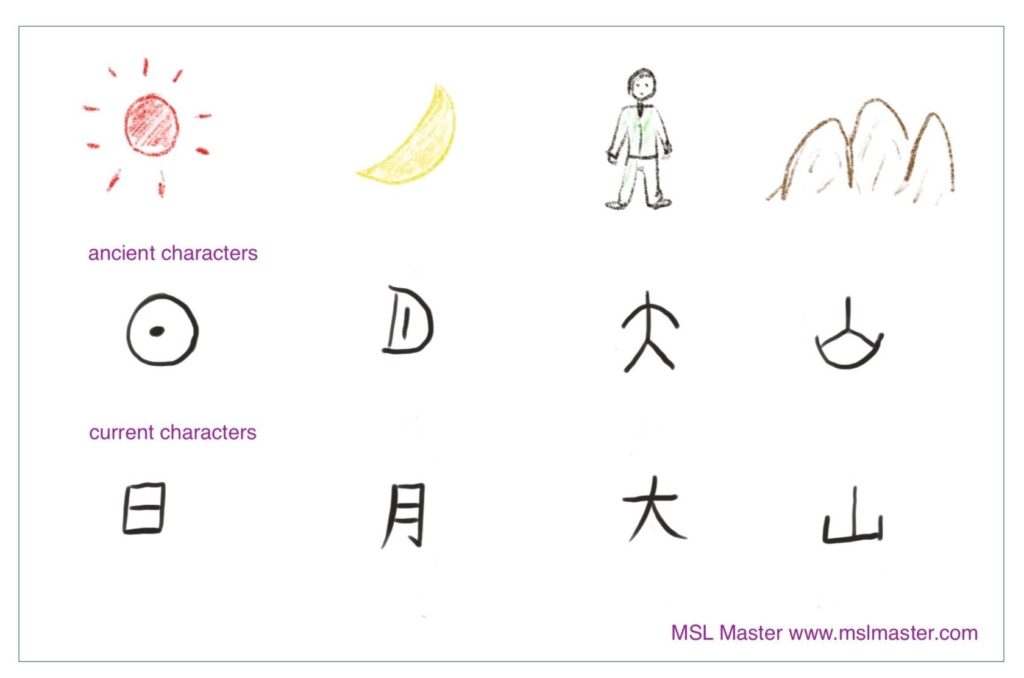Today’s aim:
- Learn to recognise 8 Chinese characters 日,月,水,火, 天,山,石,田 in their modern and ancient form.
- Learn about the use of pictograms to form ancient Chinese characters
- Learn to write the focus characters 日,月,水,火。
- Learn more classroom commands in Chinese
- learn how to combine today’s focus characters with other characters to form words
This free Mandarin Chinese continues with pages 11 and 12 of 一年级语文, the official Chinese primary schooltextbook in use in all year one Primary schools across China. This course was created during the Covid-19 pandemic by the Chinese Education Department so that students who were at home during lockdown could continue their studies. In our opinion it is the best way for children or adults to study Mandarin Chinese, and is one of the best things to have come out of lockdown. For today’s video click on this link: Chinese Textbook Primary class 7
Or click on copy link on the video below and open in a new tab.
7.1 – An Introduction to the teacher and today’s topic
In today’s class the focus is on the useful Chinese characters 日, 月, 水 and 火 meaning day, month, water and fire respectively. While useful on their own, these characters are used in a huge number of useful words that you can use in your everyday life. Have you seen these characters before? Do you know anything about the evolution of these characters? Read on to learn about the fascinating history of these 4 ancient characters.

00.05 – Teacher – 同学们好,我是北京市海淀区翠微小学贾雪芳老师。很高兴和你们一起学习第一单元第四课:日月水火。
Tóngxuémen hǎo, wǒshì Běijīng Shì Hǎidiàn qū cuìwēi xiǎoxué Jiǎ Xuě Fāng lǎoshī. Hěngāoxīng hé nǐmen yìqǐlái xuéxí dìyī dānyuán dìsì kè: rì yuè shuǐhuǒ。
Hello students, I am Jia Xue Fang of CuiWei school in the Haidian District of Beijing. Today we are studying lesson 4 of Unit 1: sun, moon, water, fire.
In the next section our teacher tells us she is going to show us round a beautiful place. She uses the following sentence。
老师 Lǎoshī (Teacher) 先 xiān (first)带 dài (guide) 你们 nǐmen (you) 去 qù (go)一个 yīgè (a) 美丽 měilì (beautiful ) 的地方 de dìfāng (place) 看一看 kànyīkàn (look).
00.18 – Teacher – 老师先带你们去一个美丽的地方看一看。
Lǎoshī xiān dài nǐmen qù yīgè měilì de dìfāng kànyīkàn。
First teacher will guide as you look around a beautiful place.
You will find the following vocabulary useful for the next section:
| Chinese | Pinyin | English |
| 请晨 | Qǐng chén | early morning |
| 火红 | huǒhóng | blazing |
| 太阳 | tàiyang | the sun |
| 升起 |
qǐ lái | rise |
| 远处 | yuǎnchù | distant |
| 高山 | gāoshān | mountains |
| 山脚 |
Shānjiǎo | foot of the mountain |
| 小河 | xiǎohé | river |
| 河边 | Hébiān | river bank |
| 石块 | shíkuài | rock |
| 田地 |
Tiándì | field |
| 禾苗 | hémiáo | grain |
| 叶子 | yèzi | leaves |
| 格外 | géwài | particulary |
| 月亮 |
yuèliang | the moon |
00.23 – Narrator – 请晨火红的太阳升起来了。可以看到远处的高山。
Qǐng chén huǒhóng de tàiyang shēng qǐ lái kěyǐ kàndào yuǎnchù de gāoshān
Early morning and the blazing sun rises in the sky, the tall mountains can be seen in the distance.
00.30 – Narrator – 山脚下流淌着一条清清的小河。河边散落着大大小小的石块。
Shānjiǎo xià liú tǎng zhe yī tiáo qīng qīng de xiǎohé。 Hébiān sànluò zhe dàdàxiǎoxiǎo de shíkuài。
Lying at the foot of the mountain flows a river with clear water. Next to the river lies some rocks of varying sizes.
00.39 – Narrator – 田地里种着禾苗绿绿的叶子格外好看。